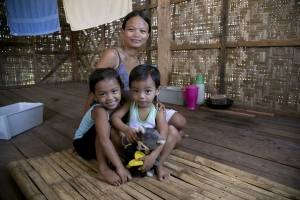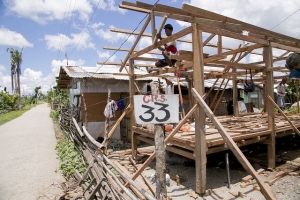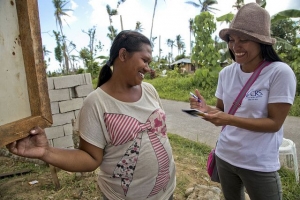
Leslie Montanejos, her husband and children are one of the families to benefit from a new home after Typhoon Haiyan. Photo by Jennifer Hardy/Catholic Relief Services
“They’ve lost everything.” You’ve seen the pictures as newscasters utter these words after a disaster—people standing in front of homes blown away by wind, washed away by water or crumbled to the ground by trembling earth.
As the survivors of Super Typhoon Haiyan can testify, people in these circumstances lose much more than walls, beds, clothes, books and pictures. Disasters also snatch away peace of mind, the ability to sleep, feelings of safety and security, a sense of control and hope.
Caritas organisations including Catholic Relief Services are working to provide transitional shelter in the wake of Haiyan, the most powerful storm ever to strike the Philippines. They are also helping people feel safe and in control of their future.
“There are so many variables: urban and rural settings, levels of damage to people’s homes, unclear land ownership, no-build zones that require people to relocate,” said Josh Kyller, coordinator of the CRS typhoon response.
“All of those factors mean we need to think creatively about each neighbourhood and family’s unique situation,” he said.
Families like Anita Punay’s received help to construct a new home.
“It’s better to sleep in my new house,” said Anita. “My old home was along the river and it was totally destroyed by [Haiyan]. We made a makeshift home in the same place. It was just salvage tin and tarp. It was very hot. In the heavy rains, water would come into the shelter and weaken it.”
Anita, her husband and 13-year-old stepson were good candidates for a grant to build a new home because they already owned a plot of land on higher ground. The family received cash in increments as they completed each stage of construction. An engineer checked to ensure the family was using disaster-resilient construction techniques.

Families are receiving shelter specially designed by engineers to meet the needs of their particular location. Photo by Jennifer Hardy/Catholic Relief Services
Anita knew what she wanted in her new home. She was able to weigh in on the design that would work best for her family. She already has plans for an expansion, including a small shop where the family can sell snacks and drinks.
“It’s good we received the grants to rebuild,” Anita said. “My husband, a plumber, used to earn [$7.86] a day. Now, he has only been able to find work as a labourer and has brought home around [$5.62] a day. That is not enough to live on. We never would have been able to save enough to build a home on our own.”
For families who have to rebuild on sites with particular challenges, the engineers help create a design that meets their needs and can be rebuilt safely on their land.
Leslie Montanejos, a young mother expecting her third child in a matter of weeks, said her land in the Cangumbang neighborhood of Palo has poor drainage and floods often. That meant that standard transitional shelter designs—built on the ground—were not a good option. Engineers recommended a raised design for the whole area. A CRS-trained foreman oversaw work crews who built shelters for the cluster of families.
“I’m so excited to move into our new home tomorrow,” said Leslie. “The new baby will have a clean and strong home when it is born.”
The raised design uses locally sourced and natural materials, including woven bamboo walls and lumber from coconut trees downed in the storm.
“I will demolish our temporary house, the one we pieced together right after the storm, and use those materials to make a kitchen for our new house,” she said. “I also know where I will hang the hammock for the new baby to sleep. I can’t wait to decorate the house,” she says. “I will hang curtains, varnish the outside and add floor mats. My favorite color is pink. Whatever I can find in pink, I will choose.”

Jessica Fernandez is pictured in front of her new home. Photo by Jennifer Hardy/Catholic Relief Services
Personalising her new home is also on the mind of Jessica Fernandez, a mother of four. She is eagerly waiting for her new home to be finished.
“My neighborhood is called Teraza, after St. Teresa,” said Jessica. “Her feast day is coming soon and the whole neighbourhood will celebrate. Now many of us will have new homes before the feast day. It will make the fiesta even more special.”
Regardless of design or location, the homes are bringing these families more than a dry, private place to live. They are bringing a feeling of security and peace. Family after family says that’s what they like most about their new home.
“I feel safer in this new house because it is strong,” says Anita Punay. “I’m thankful for the people who gave us … a peaceful place to sleep.”
